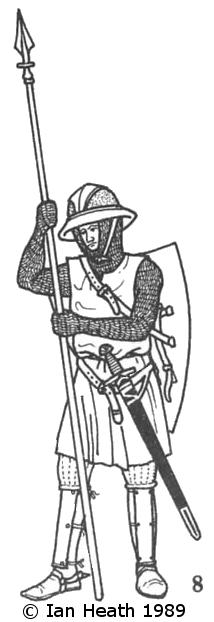|
|
MAN-AT-ARMS c.1250
An extract from Armies of Feudal Europe 1066-1300
by Ian Heath
|
|  |
8. MAN-AT-ARMS c.1250
Taken from the famous ‘Maciejowski Bible’,
this man wears plate armour for the lower leg consisting of narrow iron greaves strapped to the shins.
These appeared c.1240 and are usually called schynbalds.
However, though they are to be occasionally seen in many sources of the second half of the 13th century they seem to have nevertheless remained uncommon until the 14th century.
His shield is of a size more typical of the mid-13th century than that of
figure 10: a surviving example, that of Conrad of Thuringia (see figure 104, also shield cxxxiii in Appendix 1),
made of lindenwood with the arms embossed in leather, measures 34” deep by 28” wide.
The only other feature worthy of note is his broad-brimmed helmet.
This, the ‘kettle-helmet’ (so-called because it resembled an upturned cauldron, or ‘kettle’),
first appeared in the late-12th century and remained in use for as long as armour was worn, still surviving in much adapted form even today in every army throughout the world.
Possibly the earliest depictions of
kettle-helmets are on some of the Lewis chess pieces of c.1175
(see figures 54 and 55).
The one worn here has its side panels painted red, while his surcoat is green-grey with a red lining, sword-belt is white, scabbard black and shoes brown.
[Based on Goliath in folio 27r in the Morgan Crusader Bible of Louis IX or Maciejowski Bible or The Bible of Shah Abbas]
|
|